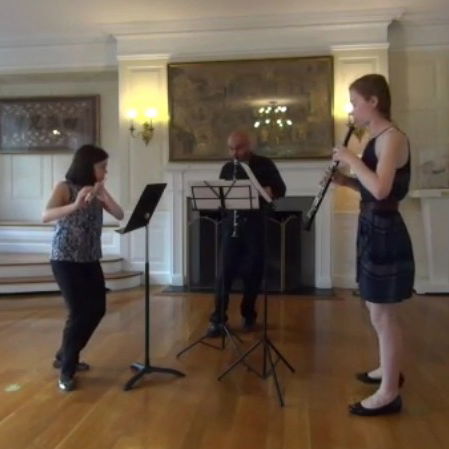Riverside Winds
Wind Trio
About
The Riverside Winds have been a successful wind trio since the summer of 2016, when the members formally came together as Kaplan Fellows at the Bowdoin International Music Festival. They met, studied, and performed together at the Manhattan School of Music. During their time at Bowdoin, the members of the Riverside Winds have both had coachings and collaborated with many sought-after musicians, including Linda Chesis, Jon Manasse, Kurt Muroki, and members of the Jupiter String Quartet.
The Riverside Winds are committed to performing both traditional concert venues and community outreach. During their six-week fellowships at Bowdoin, the members of the Riverside Winds performed several concerts weekly at retirement homes, community centers, and other public centers. They create innovative concerts that fuse standard wind trio repertoire with original transcriptions and arrangements.
Music
Trio in C major, Op.87, Ludwig van Beethoven (1770-1827)
This work was composed in 1794, when Beethoven was 24 years old. It was composed for an unusual combination of winds in order to contribute to the music played by Vienna’s growing population of amateur musicians. This is considered one of his earlier works, which entails light texture, simple phrasing, and playful style.
Divertimento for Flute, Oboe, and Clarinet, Malcolm Arnold (1921-2006)
Malcolm Arnold’s style of composition is highly characterized, and this work is a perfect example. Each of its short movements embody different emotions, which are represented in witty and charming ways. This Divertimento was written during the beginning of the height of his compositional fame, and is a particularly adventurous piece.
Histoire du Tango, Bordel, 1900, Astor Piazzolla (1921-1992)
Bordel, 1900 is the first movement of Piazzolla’s work, Histoire du Tango, a musical history of the Tango’s development in the 20th century. The Bordel was the very beginning stages of the Tango’s history, which took place in Buenos Aires, Argentina. This rhythmic movement depicts good-natured teasing of the passers-by by the dancers.
Aubade, Paul de Wailly (1854-1933)
An aubade has few interpretations. It can be a piece a music that depicts daybreak, a song from a door to a sleeping woman, or a song about lovers separating at dawn. While de Wailly’s own interpretation was not documented, he writes music that sounds agitated or, perhaps, distraught, which may indicate an unhappy parting. The work was published in 1906, when de Wailly was 52.
Umoja, Valerie Coleman (1970-)
Coleman is an active New York City-based flutist and composer whose voice brings the harmonies and rhythms of African-American culture to contemporary music. Umoja is the Swahili word for “unity,” and this work is described as a “Kwanzaa Celebration.” In addition to its dance-like rhythms, this pieces represents the importance of family and community.
Eine Kleine Nachtmusik, Allegro, Wolfgang Amadeus Mozart (1756-1791)
This work, written in 1787, was composed towards the end of Mozart’s life. Literally translated, the piece is titled “a little serenade (or night music).” Unbeknownst to him at the time, this “little” work would become one of the most famous pieces Mozart ever wrote. In spite of its current renown, the reason for its composition and premiere are still unclear.

 Continue with Facebook
Continue with Facebook
 Continue with Google
Continue with Google
 Continue with Apple
Continue with Apple